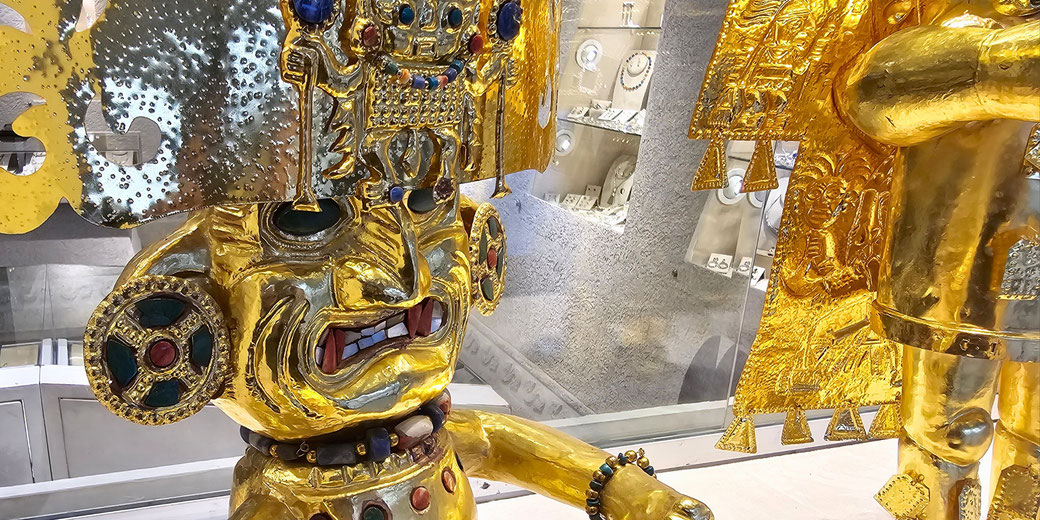What happened to all of the Inca gold?

The sudden arrival of foreign forces in the Andes in the 16th century unleashed a wave of terrible destruction on the Inca Empire as they seized territory and destroyed the culture’s sacred symbols.
Valuable religious items were taken, dismantled, melted down, and repurposed to feed the distant empire’s hunger for wealth.
What had once connected the people to gods became little more than gold bullion.
Capturing Atahualpa and the Ransom
Upon the arrival of Francisco Pizarro and his men in 1532, the Inca Empire had already mined a large amount of gold thanks to its religious and ceremonial traditions, rather than economic priorities.
Across the Andean highlands, gold was used to decorate temples, beautify royal estates, and regulaarly featured in sacred ritual objects.
The Incas did not treat gold as currency. Instead, they valued its sacred meaning as a gift from the sun god Inti.
It was typically used in sheets that were lined on the walls, or in sculptures, and in offerings placed inside burial chambers and shrines.
During the encounter at Cajamarca in November 1532, Pizarro captured the Inca ruler Atahualpa and immediately saw a chance to take riches from his captive.
The Inca emperor offered to fill a room with gold and another with silver in exchange for his release.
Over the next several weeks, Inca couriers gathered objects from throughout the empire: chalices from temples, ornaments from palaces, and idols from sacred caves.
By May 1533, the collection was largely complete. Spaniards melted most of these items down into standardised bars.
The total collection, recorded in Spanish records from the time, amounted to over 6,000 kilograms of gold and more than 13,000 kilograms of silver.
Even after the ransom had been paid, Atahualpa was still executed on 26 July 1533, after a show trial in which the Spaniards accused him of plotting against them.
Looting Cuzco and Ceremonial Centres
Following Atahualpa’s death, the Spanish continued their advance into Inca territory and reached the city of Cuzco, which was both a political capital and the empire's most important religious centre.
Inside the Coricancha, the most sacred temple in the empire, they found walls covered in gold panels, as well as statues and ornaments made entirely of gold.
Everything that could be removed was taken. Gold panels were pried from walls, melted, and cast into ingots.
Objects representing llamas, maize stalks, and human figures, each of which held religious meaning, disappeared into smelting furnaces, although a few may have been hidden or preserved by local priests and caretakers.
The looting quickly spread to other ceremonial sites, where Spaniards dismantled tombs and sacred temples, as well as stripping artefacts from sanctuaries.
While the Spanish transported large amounts of gold back to the coast, many journeys moved into faraway areas in search of further treasure.
Stories circulated about hidden cities filled with gold, secret caves containing royal treasures, and lakes concealing religious gifts.
The most famous of these legends involved Lake Titicaca, where priests had allegedly cast offerings into the water to keep them from Spanish hands.
Though modern divers have recovered some ancient artefacts from the lakebed, no large-scale hoard from the Inca period has been found.
Transatlantic Shipments and Economic Impact
Most of the gold collected by the conquistadors was shipped north to Panama and then across the Atlantic to Spain.
The Casa de Contratación in Seville recorded numerous cargoes that included precious metals from Peru, though some records have been lost, and specific details about Inca gold still remain incomplete.
While some vessels were lost to storms or seized by pirates, a large part of the treasure reached Spain and entered royal treasuries or European markets.
Ironically, the sudden increase in gold and silver supply contributed to economic problems in Spain, including widespread price increases and the later weakening of its economy during the seventeenth century.
Relatively few original Inca gold artefacts survived as most objects were melted before reaching Europe.
Those that escaped destruction remained hidden in isolated villages or were secretly kept by Indigenous communities.
Others found their way into colonial churches, where they were repurposed as Christian religious items used in worship.
In rare cases, items made of gold have been recovered by history experts, and are now displayed in Peruvian museums, which now offer a glimpse of the skilled work and spiritual meaning that once defined Inca metalwork.
In the centuries following the conquest, Inca gold came to stand for the beauty of the lost Inca world and the greed of those who ruined it.
The wealth that once decorated temples with lavish materials, honoured deities through ritual, and expressed sacred ideas by embedding meaning into artistic symbols was transformed into bullion for European use.
Although Peru retains a strong cultural identity linked to its Inca past, now influenced also by Spanish and other cultures, the material heritage of that empire vanished into Spanish hands and was reduced to ingots cast in Spanish furnaces, to produce coins that circulated through European markets.
What do you need help with?
Download ready-to-use digital learning resources
Copyright © History Skills 2014-2025.
Contact via email
With the exception of links to external sites, some historical sources and extracts from specific publications, all content on this website is copyrighted by History Skills. This content may not be copied, republished or redistributed without written permission from the website creator. Please use the Contact page to obtain relevant permission.





